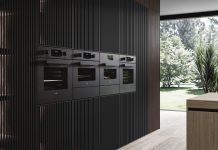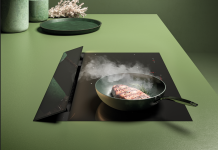“100 years of better”: with these words Panasonic celebrates its long activity in the sign of innovation. The company that was to become Panasonic was started on March 7th,1918, when Konosuke Matsushita moved from his tiny dwelling to a larger two-story house, and set up Matsushita Electric Housewares Manufacturing Works. The company continued to growth during the years and on October 1st, 2008, the year marking its 90th anniversary, it changed its name to “Panasonic Corporation”: here are some steps of its success in the household appliances sector, as communicated by Panasonic.
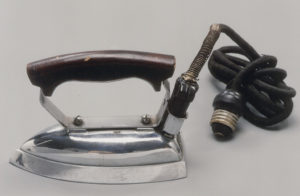
1927
Established the Electric Heating Department
The founder, Konosuke Matsushita, established the Electric Heating Department because he wanted to produce high-quality electric devices at prices that the ordinary home could afford. With this in mind, development first started on irons. The “Super Iron”, which was launched three months later, used a new structure in which the heater was sandwiched between iron plates. Offering the same level of quality as conventional irons, its price was 30% lower. The engineer who developed the “Super Iron”, Tetsujiro Nakao, created a wide variety of new technologies and new products as a leader in Panasonic technology.
1935
Launched Panasonic’s first coffee machine and toaster
1937
Launched Panasonic’s first home dryer
Equipped with a brush replacement socket and a three-stage switch. Packaged in a wooden case.
1948
Launched the first electric fan under the National Brand

1951
Launched the MW-101, Panasonic’s first washing machine
After making an observation tour of the U.S. market, the founder, Konosuke Matsushita, instructed Panasonic engineers to produce a washing machine with the thought that “It was a highly important product to free housewives from the hard work of washing clothes”. As a result, in this year, the company’s first agitator-type washing machine, the MW-01, was released. In 1956, a washing machine, a black & white TV, and a refrigerator were called the “three essential status symbols” that everyone sought in Japan.
1952
Launched the MX-2, Panasonic’s first electric mixer
Panasonic launched its first motor-driven kitchen appliance, the MX-2.
1953
Launched Panasonic’s first electric refrigerator
Panasonic launched the NR-351, its first electric refrigerator.
1954
Launched the MC-1, Panasonic’s first vacuum cleaner
Panasonic launched its first vacuum cleaner, the compact handheld MC-1.
1956
Launched the MC-2 vacuum cleaner
The MC-2, Panasonic’s first vacuum cleaner with a built-in dust collector, was launched.

1960
Launched the MR-500, Japan’s first electric automatic dishwasher
The MR-500, the first electric automatic dishwasher with full-fledged rotation injection system in Japan was launched. The product never reached mainstream popularity, primarily due to its large size, as it was designed from the body of a washing machine, and its high cost.
1960
Launched the MK-800, Panasonic’s first clothes dryer
1960
Launched the NR-61, Panasonic’s first electric oven
1961
Launched the WH-620, Panasonic’s first air conditioner
1965
Launched the N-7000, a fully automatic washing machine
Panasonic launched the N-7000, the company’s first fully automatic washing machine that enabled users to wash, rinse, and spin-dry laundry with one tank and automated the process from pouring in the water to the final spin-drying.
1973
Launched the NR-450SS, Panasonic’s first household refrigerator
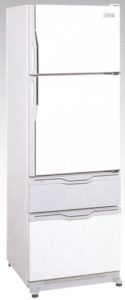
1984
Launched the NR-304CV refrigerator equipped with partial freezing function
Defying the conventional wisdom that “freezing is necessary for the long-term storage of food,” a partial freezing function at a temperature of -3°C was adopted for this refrigerator model. Compared with freezing, foods don’t become hard, so they can be used for cooking as soon as they are taken from the refrigerator. The flavor and nutrients are also not lost due to the dripping that occurs during thawing. Merits such as these are highly appraised, and partial freezing has become a popular function on Panasonic refrigerators.
1990
Launched the “Brenby” NV-S1 video camera with image stabilization function
The “Brenby” NV-S1 was equipped with a Fuzzy Gyro image stabilization function.
1991
Established the Matsushita Air-Conditioning R&D Center
Matsushita Air-Conditioning R&D Center Malaysia was established to conduct R&D on air conditioners. Then, in 1997, Matsushita Compressor & Motor R&D Center Malaysia was set-up to develop compressors.
1993
Launched Panasonic’s first “Flat Vision” Thin-Screen Color TV
1998
Launched the CS-XG25M, the industry’s first air conditioner to use R410 refrigerant
Instead of the commonly used R22 refrigerant, this air conditioner used R410 refrigerant, with a lower ozone layer depletion coefficient. This allowed the company to achieve production that considered the environment at an earlier stage than many other manufacturers.
2001
Launched the RR-XR330 IC recorder with SD memory card compatibility
Equipped with a 64-MB SD Memory Card, this IC recorder was capable of approximately 10 hours and 50 minutes of recording time. It included an LCD level meter to visually confirm the set recording level.
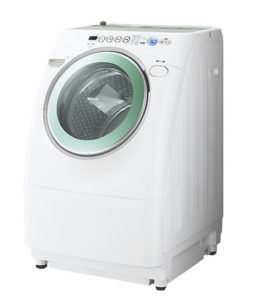
2003
Launched the NA-V80, the world’s first tilted drum-type washing machine and dryer
By tilting the drum and using the drum corners, the washing machine and dryer achieved significant water savings. It also received rave reviews for its ease of inserting and removing clothes to and from the inside of the drum.
2004
Completed 100% non-CFC conversion of household refrigerators
Because the ozone layer was being destroyed by Freon, which was a common refrigerant in refrigerators, switching to CFC substitutes was being carried out in the latter half of the 1990s. However, the substitute CFC contributed to global warming as a problematic side effect. Panasonic responded to this quickly and announced the first non-CFC refrigerator in Japan in November 2001. Three years later, in April 2004 for domestic, and September for exports, the company completed a 100% non-CFC changeover for household refrigerators.
2006
Reached the world’s first air conditioning compressors production cumulative total of 200 million units
On September 6th 2006, Panasonic reached the world’s first cumulative global production of air conditioning compressors of 200 million units.
2008
Reached the world’s first tv production cumulative total of 300 million units
After achieving a production total of 100 million units in 1985, and then 200 million in 1998, Panasonic achieved 300 million units* in TV production in 2008, 56 years after their first TV was produced in 1952.
*Cumulative production by brand (National: 105 million units/Panasonic: 195 million units)
2009
Panasonic Mexico started LCD TV Eexport to Latin American Countries
2012
Established the Extrema Factory, a manufacturing base for appliances in Brazil
A new factory for large-scale appliances was opened in Extrema, Brazil. This factory, which served as a state-of-the-art manufacturing base for facilities, construction methods and product designs, began production of refrigerator and after washing machines in 2014.
2013
Cumulative global production of washing machines reached 100 million units
Panasonic Corporation Appliances, which started production on September 1951, achieved production of 100 million washing machine units on August 23, 2013.

2017
Achieved the 1,000,000th product produced in Extrema Factory, Brazil
Extrema factory completed the 1,000,000th product produced in 5th Anniversary of foundation.

